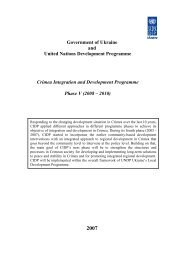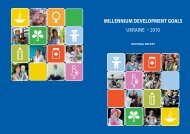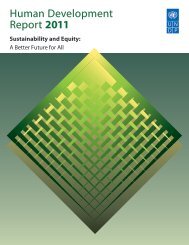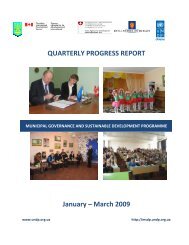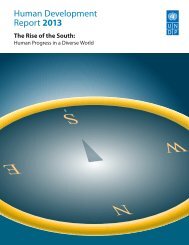E N S W - United Nations Development Programme
E N S W - United Nations Development Programme
E N S W - United Nations Development Programme
You also want an ePaper? Increase the reach of your titles
YUMPU automatically turns print PDFs into web optimized ePapers that Google loves.
a fulfilling life according to his or her ownvalues and aspirations. No one should bedoomed to a short life or a miserable onebecause he or she happens to be from the“wrong” class or country, the “wrong” ethnicgroup or race or the “wrong” sex. Inequalityreduces the pace of human development andin some cases may even prevent it entirely.Globally, there have been much greater reductionsin inequality in health and education inthe last two decades than in income (figure4). Virtually all studies agree that global incomeinequality is high, though there is noconsensus on recent trends.A more global SouthGlobal production is rebalancing in ways notseen for 150 years. Growth in the cross-bordermovement of goods, services, people and ideashas been remarkable. By 2011, trade accountedfor nearly 60% of global output. Developingcountries have played a big part in this (box 2):between 1980 and 2010, they increased theirshare of world merchandise trade from 25% to47% and their share of world output from 33%to 45%. Developing regions have also beenstrengthening links with each other: between1980 and 2011, South–South trade as a shareof world merchandise trade rose from 8.1% to26.7% (figure 5).All developing countries are not yet participatingfully in the rise of the South. The pace ofchange is slower, for instance, in most of the 49least developed countries, especially those thatare landlocked or distant from world markets.Nevertheless, many of these countries havealso begun to benefit from South–South trade,investment, finance and technology transfer.There have, for example, been positive growthspillovers from China to other developingcountries, particularly close trading partners.These benefits have to some extent offset slackeningdemand from the developed countries.Growth in low-income countries would havebeen an estimated 0.3–1.1 percentage pointslower in 2007–2010 had growth fallen at thesame rate in China and India as in developedeconomies.Many countries have also benefited fromspillovers into sectors that contribute to humanFigure 3The middle class in the South is projected to continue to growMiddle class population (billions)2009World:1.845 billionEuropeCentral and South Americadevelopment, especially health. Indian firms,for example, are supplying affordable medicines,medical equipment, and informationand communications technology products andservices to countries in Africa. Brazilian andSouth African companies are doing the same intheir regional markets.Nevertheless, exports from larger countriescan also have disadvantages. Large countriesgenerate competitive pressures in smallercountries that can stifle economic diversificationand industrialization. But there are alsoinstances where competitive jolts have beenfollowed by industrial revival. A competitiverole today may easily turn into a complementaryrole tomorrow. Moving from competitionto cooperation seems to depend on policies fordealing with new challenges.Drivers of developmenttransformationMany countries have made substantial progressover the past two decades: the rise of the Southhas been fairly broad-based. Nevertheless,several high achievers have not only boosted2020 2030World:3.249 billion.032.057.105.165.181.664.251.703.338 .333.5251.740Asia–PacificMiddle East and North AfricaWorld:4.884 billion.107.234.313.3223.228.680North AmericaSub-Saharan AfricaNote: The middle class includes people earning or spending $10–$100 a day (in 2005 purchasing power parity terms).Source: Brookings Institution 2012.All developingcountries are not yetparticipating fully inthe rise of the SouthSummary | 3





